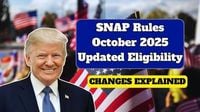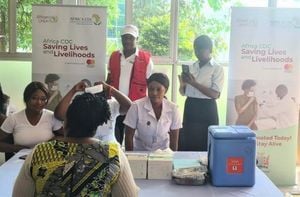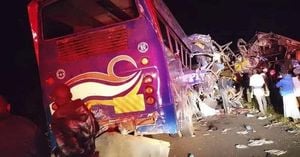Millions of Americans who rely on food assistance are facing a season of change, uncertainty, and, for some, hope. With October 2025 ushering in a raft of new rules, benefit increases, and looming legislative threats, families from California to Maine are scrambling to understand what these changes mean for their dinner tables and their futures. The Supplemental Nutrition Assistance Program (SNAP)—the country’s largest food aid initiative—remains a lifeline for over 41 million people, and California’s state version, CalFresh, supports more than 5 million residents alone. But despite modest increases in benefits designed to help families keep pace with inflation, recent federal legislation may soon test the resilience of this vital safety net.
According to the Los Angeles Times, starting October 1, 2025, CalFresh recipients in California saw a cost-of-living adjustment (COLA) that nudged their monthly benefits upward. For a family of four, that means an extra $19 per month; for a family of six, an additional $33. Even single-person households saw their maximum monthly benefit rise by $6, bringing the new total to $298. The minimum benefit for one- and two-person households ticked up from $23 to $24. These figures, though modest, offer a bit of breathing room for families grappling with soaring grocery prices. The new maximums now range from $298 for one person to $1,792 for an eight-member household, with each additional person adding $224 to the monthly allotment.
But just as families began to adjust to these new numbers, a storm cloud appeared on the horizon: the One Big Beautiful Bill Act (OBBBA), signed into law by former President Donald Trump on July 4, 2025. While the act was hailed by its supporters as a “gift to the American people,” it introduces sweeping changes that threaten to undermine recent gains for food assistance recipients. Chief among its provisions are stricter work requirements for adults without dependents. These individuals must now work at least 20 hours per week to keep their benefits; otherwise, they’re limited to just three months of support within any three-year period. Although the exemption age has been raised to 60, the law eliminates special exemptions for veterans and rural residents—groups who previously found it easier to qualify for ongoing aid.
Analysts cited by CalMatters warn that nearly 3 million young adults nationwide could lose their food assistance due to these new rules. For many, that’s a devastating prospect. As one community advocate told Sacramento Bee, “We’re seeing families who were just getting back on their feet now facing the real possibility of losing the support that keeps food on the table.”
Perhaps even more alarming is the OBBBA’s failure to fully fund SNAP for the coming year. Without proper allocations for 2026, benefit processing could grind to a halt as soon as November 1, 2025. That would leave millions—including the more than 5 million Californians who depend on CalFresh—without access to their Electronic Benefit Transfer (EBT) cards. In a state already struggling with high inflation and a stubbornly high cost of living, the consequences could be catastrophic. Food banks and community organizations are bracing for a surge in demand if payments are interrupted.
Meanwhile, the U.S. Department of Agriculture (USDA) has rolled out its own set of reforms to SNAP nationwide. According to the USDA’s official updates, October 2025 saw higher income limits, stricter eligibility verification, and updated payment schedules—all designed to improve efficiency and fairness in benefit distribution. Households now must have gross monthly earnings at or below 130% of the Federal Poverty Level (FPL) to qualify, with the new limit for single-person households set at $1,580 and $2,137 for two-person families. Asset limits remain at $2,750, or $4,250 for households with seniors or disabled members.
States have adopted staggered or regionally synchronized payment schedules to ensure smoother distribution and prevent system overloads. Beneficiaries are encouraged to check their local Department of Human Services portals for exact deposit dates and to report any changes in income or household composition within ten days—a rule designed to prevent overpayments and fraud. The USDA has also streamlined the application process, with online submissions and document uploads through Benefits.gov, making it easier for families to apply and maintain eligibility without mountains of paperwork.
On the ground, these changes mean that families must stay vigilant. As the San Francisco Chronicle reports, “Applicants must now provide updated income proof, address confirmation, and verification of household composition.” States are increasingly relying on automated database checks to root out duplicate or fraudulent claims, a move that, while improving program integrity, can also catch honest families off guard if their paperwork isn’t in order.
How are benefits calculated? It’s a simple formula: the maximum allotment minus 30% of the household’s net income. Those with little or no income get the full amount, while families with higher earnings receive less. For October 2025, the USDA’s national benchmarks list maximum monthly benefits as follows: $291 for one person, $535 for two, $766 for three, $973 for four, $1,155 for five, and $1,386 for six. These numbers are slightly lower than California’s CalFresh maximums, reflecting the state’s higher cost of living. Alaska, Hawaii, and U.S. territories have even higher caps.
The message from officials and advocates is clear: stay informed and proactive. If you’re a CalFresh or SNAP recipient, update your personal information, track your payment dates, and report any changes as soon as possible. For those worried about the OBBBA’s impact, local CalFresh offices and community organizations can help review your case, explain new reporting rules, and guide you through any eligibility changes.
Despite the uncertainty, SNAP and CalFresh remain crucial lifelines for millions. As the Los Angeles Times puts it, “The CalFresh program remains a vital lifeline for millions in California, providing essential food support during challenging times.” The modest COLA increase in October offers a buffer against inflation, but with the OBBBA’s restrictions looming, families face a future that’s anything but certain. For now, the best defense is knowledge: understanding the new rules, keeping paperwork current, and seeking help when needed can make all the difference in keeping food on the table as America’s food assistance landscape shifts once again.




